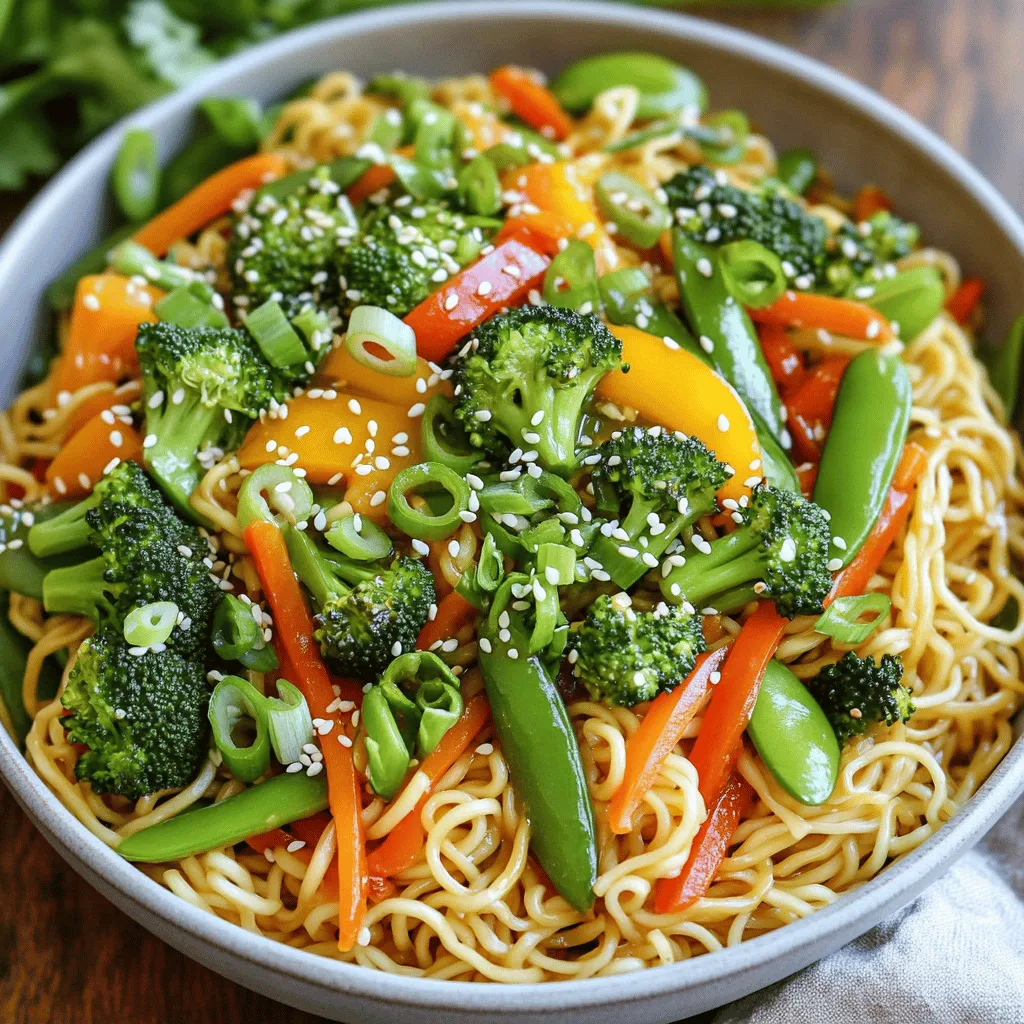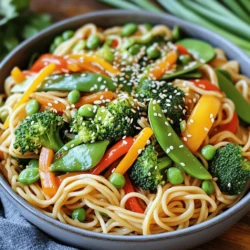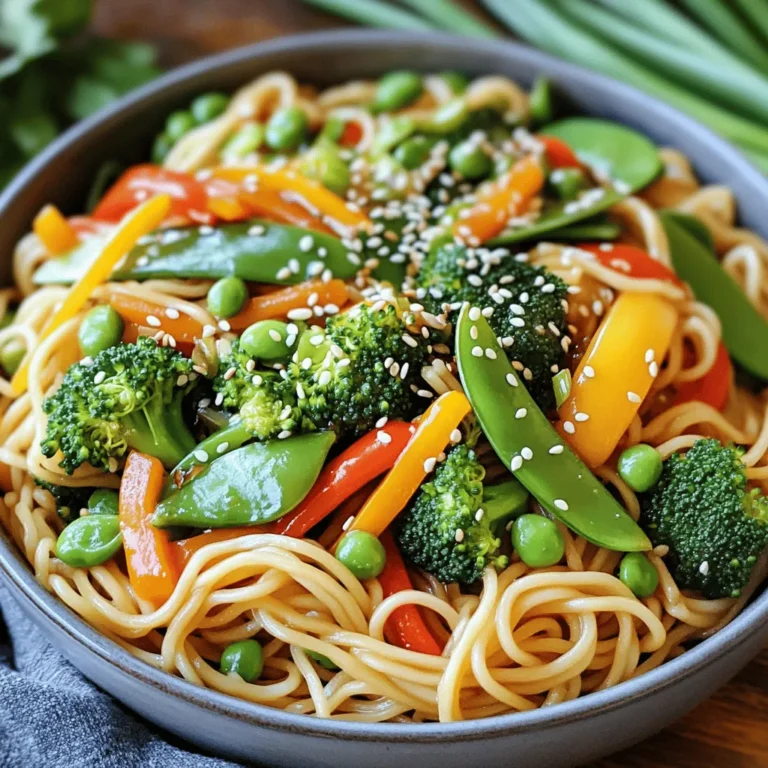Are you ready to whip up a delicious Vegetable Lo Mein that’s both colorful and easy? This tasty stir-fry dish brims with fresh veggies and bold flavors, making it a perfect weeknight meal. Whether you’re a cooking pro or just starting out, my step-by-step guide will help you create a satisfying dish in no time. Let’s dive into the world of Vegetable Lo Mein!
Ingredients
Main Ingredients for Vegetable Lo Mein
To make a delicious Vegetable Lo Mein, gather these main ingredients:
– 8 oz lo mein noodles
– 2 tablespoons vegetable oil
– 1 cup broccoli florets
– 1 bell pepper, thinly sliced (red, yellow, or green)
– 1 cup snap peas, trimmed
– 1 medium carrot, julienned
– 3 green onions, chopped
– 3 cloves garlic, minced
– 1 tablespoon fresh ginger, grated
– 3 tablespoons soy sauce
– 1 tablespoon hoisin sauce
– 1 teaspoon sesame oil
– Salt and pepper to taste
– Toasted sesame seeds for garnish
These ingredients create a colorful and tasty dish. Each one adds its unique flavor and texture. The lo mein noodles provide a soft base, while the veggies give crunch and color.
Optional Add-Ins
You can enhance your Vegetable Lo Mein with optional add-ins. These include:
– Tofu
– Mushrooms
– Baby corn
– Bok choy
Feel free to mix and match these extras based on what you like. Tofu adds protein, while mushrooms add umami flavor. Choose what fits your tastes best!
Grocery Shopping Tips
When shopping for fresh vegetables, look for these tips:
– Select bright, crisp vegetables. Avoid wilted or brown spots.
– Choose firm broccoli and snap peas. This shows they’re fresh.
– Look for vibrant bell peppers. They should feel heavy for their size.
For specialty Asian ingredients, check local Asian markets. They often have a wider selection than regular grocery stores. You can find lo mein noodles, hoisin sauce, and more. Make sure to check the expiration dates for freshness.
With these ingredients and tips, you’re ready to cook an amazing Vegetable Lo Mein.
Step-by-Step Instructions
Cooking the Noodles
To make great lo mein, start with the noodles. Bring a large pot of water to a boil. Add the lo mein noodles. Cook according to the package instructions, usually 5 to 7 minutes. Stir the noodles gently to prevent them from sticking. Once cooked, drain the noodles. Toss them with a little vegetable oil to keep them from clumping together. Set them aside for later.
Sautéing the Vegetables
Next, let’s sauté the vegetables. Heat a large wok or skillet over medium heat. Add vegetable oil and let it warm up. Start by adding minced garlic and grated ginger. Cook for about 30 seconds. You want to smell that lovely aroma.
Then, add the broccoli florets. Sauté them for 2 to 3 minutes until they soften. After that, toss in sliced bell pepper, snap peas, and julienned carrot. Keep stir-frying for another 3 to 4 minutes. The goal is to have vibrant, tender-crisp veggies.
Combining the Ingredients
Now it’s time to mix everything together. In a small bowl, combine soy sauce, hoisin sauce, and sesame oil. Pour this sauce over the sautéed vegetables. Stir well to coat every piece.
Next, add the cooked lo mein noodles to the wok. Toss everything together for about 2 to 3 minutes. You want the noodles to absorb the flavors. Adjust the seasoning with salt and pepper.
Tips & Tricks
Choosing the Right Noodles
Lo mein noodles are soft and chewy. They differ from other noodles like chow mein. Chow mein noodles are crispy and fried. For the best taste, choose fresh lo mein noodles. They cook faster and taste better. Dried lo mein noodles work too, but they take longer to cook. Always check the package for cooking times.
Enhancing Flavor Profiles
To improve the taste, consider marinating your vegetables. Use soy sauce, ginger, and a splash of sesame oil. Let them sit for a few minutes. This step adds depth to your dish. You can also add garlic while you sauté. Fresh herbs like basil or cilantro can brighten the flavor. A squeeze of lime juice can also enhance the taste.
Presentation Suggestions
Presentation matters when serving food. Use wide, shallow bowls for your Vegetable Lo Mein. This allows you to show off the colorful veggies. Garnish with chopped green onions and sesame seeds. You can even add a few slices of lime on the side. This adds a nice pop of color and flavor. A sprinkle of fresh herbs can elevate the look even more. For a fun touch, try serving with chopsticks!

Variations
Dietary Adjustments
You can easily adapt Vegetable Lo Mein for different diets. For vegetarians, this dish is already perfect as it uses only vegetables. For vegans, just ensure your sauces are free from animal products. Many soy sauces are vegan, but always check the label. If you need a gluten-free option, substitute traditional soy sauce with tamari. This change keeps the flavors strong without the gluten. You can also use rice noodles instead of lo mein noodles for a gluten-free base.
Regional Variations
Vegetable Lo Mein changes across Asian cuisines. In China, it often has more soy sauce and fewer veggies. In contrast, Thai versions may use more fresh herbs and spices. Japanese stir-fry might include a dash of mirin for sweetness. Each region highlights its local flavors, making the dish unique everywhere you go. Experimenting with these variations can introduce new tastes to your table.
Customizing with Protein
If you want to make your Vegetable Lo Mein heartier, add protein. Chicken, beef, or shrimp can elevate this dish. Start by cooking the protein in your wok before adding vegetables. This way, the meat gets the flavors from garlic and ginger. Once cooked, toss in your veggies as usual. You can also use tofu for a plant-based protein option, which absorbs the sauce flavors nicely. This allows you to tailor the dish to your taste and dietary needs. Enjoy customizing your own Veggie Paradise Lo Mein!
Storage Info
How to Store Leftovers
To keep your Vegetable Lo Mein fresh, let it cool first. Then, place it in an airtight container. You can store it in the fridge for up to three days. If you want to keep it longer, freeze it for up to three months. Just make sure to label your container with the date. This helps you track how long it has been stored.
Reheating Tips
When reheating, avoid the microwave if possible. The microwave can make the noodles mushy. Instead, use a skillet or wok. Heat a little oil in the pan and add your leftovers. Stir-fry them on medium heat for about five to seven minutes. This keeps the texture and flavor intact. You can also add a splash of soy sauce for extra taste.
Shelf Life of Ingredients
Most of the fresh veggies in Vegetable Lo Mein last about a week. Broccoli and bell peppers stay fresh for five to seven days. Garlic and ginger can last longer, about two weeks if stored properly. Soy sauce and hoisin sauce have a long shelf life. They can last several months in your pantry, even longer when opened if stored in the fridge. Always check for any signs of spoilage. Enjoy the freshness of your ingredients!
FAQs
Can I use other types of noodles for Vegetable Lo Mein?
Yes, you can use different noodles. Try egg noodles, rice noodles, or even spaghetti. Each type adds a unique twist to the dish. Just adjust the cooking time based on the noodles you choose.
What can I substitute for hoisin sauce?
If you lack hoisin sauce, mix soy sauce and peanut butter. This blend gives a similar sweet and savory taste. You can also use plum sauce or teriyaki sauce for a different flavor profile.
How do I prevent my vegetables from getting soggy?
To keep vegetables crisp, stir-fry them on high heat. Cook them briefly, just until tender-crisp. Use fresh veggies and avoid overcrowding the pan. This helps them cook evenly and stay vibrant.
Is Vegetable Lo Mein a healthy dish?
Vegetable Lo Mein can be healthy. It uses lots of fresh vegetables and can be low in fat. Opt for whole grain noodles for extra fiber. Control the sauce quantity to manage sodium levels.
Can I prepare this dish ahead of time?
Yes, you can prep the veggies and noodles in advance. Store them separately in the fridge. When ready to eat, just stir-fry everything together. This keeps the dish fresh and tasty.
In this post, we explored the essentials for making delicious Vegetable Lo Mein. We detailed key ingredients, valuable grocery tips, and step-by-step cooking directions. You learned how to select fresh veggies and enhance flavors. We also discussed variations and storage practices for leftovers.
Now, you have the tools to create a tasty dish that fits your needs. Enjoy experimenting and sharing this flavorful meal with others!


